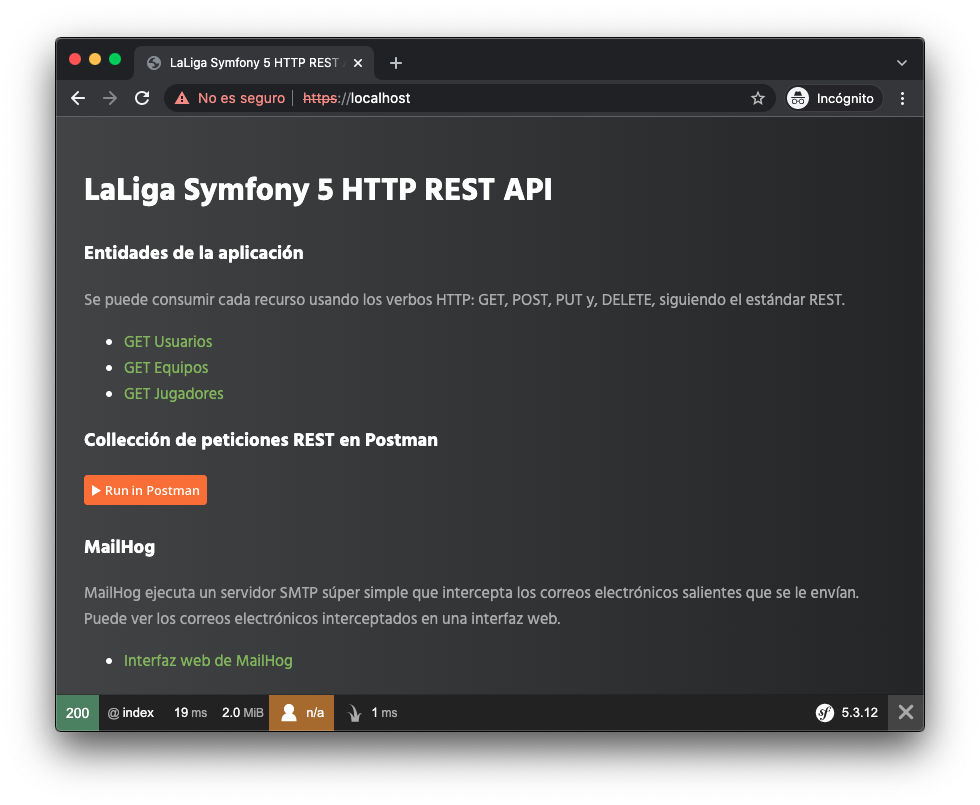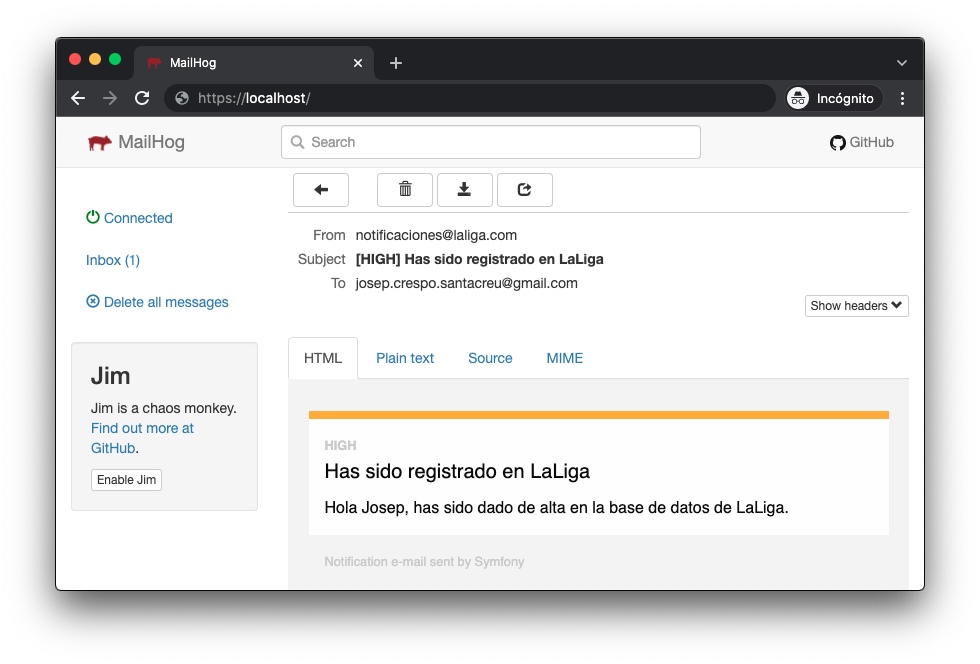This app implements an HTTP cached REST api with api key based security in Symfony.
The app utilizes and properly configures, the following bundles...
- FOSHttpCacheBundle
- FOSRestBundle
- Symfony SecurityBundle
- DoctrineBundle
- DoctrineMigrationsBundle
- JMSSerializerBundle
- SensioFrameworkExtraBundle
- HautelookAliceBundle
The provided Docker Compose configuration simplifies the implementation of the development environment, and will handle starting up the app. The docker environment consists of the following..
- PHP 8.0 FPM
- PostgreSQL 13.1
- Caddy 2.3.0
Caddy provides automatic HTTPS, and will expose the app at port 443 via the domain specified in an APP_URL environment variable. Be sure to add this domain (the one you set at APP_URL) to your etc/hosts file.
By default, APP_URL is set to localhost and, the final url will be https://localhost. You don't need to do any extra setup in that case.
- Docker implementation includes PHP FPM, PostgreSQL, and Caddy server.
- Fully function REST API with
GET,GET all,POST,PUT, andDELETEfunctionality. - API key based authentication for
POST,PUT, andDELETErequests. - Automatic invalidation of url's upon
POST,PUTandDELETErequests. - Sensitive information scrubbing at serialization (such as User passwords, and api keys).
- Automatic association resolving (Associated entities will be included in json).
- Sort, limit, and offset results of
GET allrequests. - Automatic HTTPS via Caddy Server.
- Enable and Disable HTTP Cache via
APP_CACHEenvironment variable. - Automatic encoding of User passwords via Doctrine Listener, upon Persist, and Modification.
- Automatic conversion of Markdown to HTML via Doctrine Listener, upon Persist, and Modification.
- Fixtures created via
hautelook/alice-bundle. - User, Category, Tag, Article, ProjectCategory, Project entities provided.
- Rename
.env.distto.env. - Run
docker compose up. - Enter https://localhost/ in your favorite web browser.
The app runs a local SMTP mail server, MailHog.
MailHog runs a super simple SMTP server that hogs outgoing emails sent to it. You can see the hogged emails in a web interface.
A note on POST, PUT, and DELETE Requests:
In order to run any POST, PUT, or DELETE requests, you'll need to send a valid API key in the X-AUTH-TOKEN header or using the Bearer token strategy. To acquire an API key, you'll need to create an initial user by installing the fixtures. Passwords, and API keys, are scrubbed from the JSON during serialization, so in order to actually retrieve the api key, you'll need to load up the database in an app like TablePlus.
The app includes a couple of custom event listeners that enable automatically resolving entity associations, and resource names during the request. Take a look at src/EventListener/AssociationNormalizingListener.php and /src/EventListener/ResourceResolvingListener.php to see how they work.
The entire api is implemented in one Controller across 5 methods. Take a look at the sole Controller /src/Controller/RestController.php to see how it all works.
The following requests are accepted:
GET: /api/{resource}/{id}
GET All: /api/{resource}
POST: /api/{resource}
PUT: /api/{resource}/{id}
DELETE: /api/{resource}/{id}
Note: The GET all request accepts three query parameters: order, limit, and offset. These are passed directly to the Doctrine findBy() method. Address the Doctrine documentation for further information.
Note: The POST, PUT, and DELETE endpoints require that a valid api key is passed via the X-AUTH-TOKEN header or using the Bearer token strategy. Take a look at /src/Security/ApiTokenAuthenticator.php and /config/packages/security.yaml to see how I implemented that.
Login with valid user and password credentials:
POST request to /login.
The body of the request should be set as application/json.
{
"email": "admin@laliga.com",
"password": "asdf1234"
}Success response to POST /login request.
{
"email": "admin@laliga.com",
"api_token": "b5d0e7-3f163d-6a3227-c44d54-484b7d"
}POST request to /api/team.
The body of the request should be set as application/json.
The request should include the X-AUTH-TOKEN HTTP header, or follow the Bearer token strategy, with a valid API token.
{
"name": "Real Madrid",
"salary_limit": 55123456
}Valid values for the position property are as follows:
PorteroDefensaCentrocampistaDelantero
POST request to /api/player.
The body of the request should be set as application/json.
The request should include the X-AUTH-TOKEN HTTP header, or follow the Bearer token strategy, with a valid API token.
{
"name": "Ronaldo",
"birth_date": "1985-02-05",
"position": "Delantero",
"salary": 2600000,
"team": 1,
"email": "ronaldo@fifa.com"
}A collection of REST API requests that runs in Postman.
The FOSHttpCacheBundle simplifies the process of implementing a gateway cache in Symfony. According to the bundle's docs, it's features include...
- Set path-based cache expiration headers via your app configuration;
- Set up an invalidation scheme without writing PHP code;
- Tag your responses and invalidate cache based on tags;
- Send invalidation requests with minimal impact on performance;
- Differentiate caches based on user type (e.g. roles);
- Easily implement your own HTTP cache client.
I've chosen to implement the Symfony based HTTP cache. That being said, Varnish and Nginx implementations are included by the bundle. See the documentation for more information.
A note on expiration:
Typically when configuring expiration headers, we use the max-age or s-max-age headers. The max-age header is honored by the browser when it caches requests. The s-max-age is used by reverse proxies such as Nginx, as well as CDN's like Cloudflare.
However this leads to a problem when using Symfony as a gateway cache. If I configure the Symfony gateway cache to cache an endpoint for 86400 seconds, I only want the Symfony cache to do so and not another cache implementation that may receive the request before Symfony does. Such as an Nginx reverse proxy.
The bundle authors have thankfully addressed this issue by implementing a reverse_proxy_ttl header that only the Symfony gateway cache honors.
You can of course still set, max-age, or s-max-age headers. In fact a common strategy recommended is to set the max-age header to a shorter length such as 500, and then the reverse_proxy_ttl to a longer length such as 86400. The max-age header allows the users own browser to cache the request during the short term and not any other cache implementations. And then the reverse_proxy_ttl directs the Symfony caches ttl which will be served to everyone. Remember we can't directly control the users browser cache. We can however, control and invalidate the Symfony gateway cache at will.
Issues I Addressed:
A major issue that I encountered with the bundle was disabling the http cache during development. Even when disabling the http cache the 'normal' way, Symfony was still picking up the fos_http_cache.yaml bundle configuration and somehow implementing certain cache features.
Here is the standard way the bundle recommends implementing the http cache:
// /public/index.php
// ...
$kernel = new Kernel($_SERVER['APP_ENV'], (bool) $_SERVER['APP_DEBUG']);
$kernel = $kernel->getHttpCache();
$request = Request::createFromGlobals();
$response = $kernel->handle($request);
// ...// /src/Kernel.php
// ...
class Kernel extends BaseKernel implements HttpCacheProvider {
use MicroKernelTrait;
use HttpCacheAware;
public function __construct(string $environment, bool $debug) {
parent::__construct($environment, $debug);
$this->setHttpCache(new CacheKernel($this, null, ['debug' => $debug]));
}To fix this, I decided to..
- implement an
APP_CACHEenvironment variable. When set to false, the http cache disables. - Remove
fos_http_cache.yamlfrom/config/packages/fos_http_cache.yamland move it to/config/http_cache/fos_http_cache.yaml. - In
/src/Kernel.phpand/public/index.phpI made the following additions..
// /public/index.php
// ...
$kernel = new Kernel($_SERVER['APP_ENV'], (bool) $_SERVER['APP_DEBUG'], (bool) $_SERVER['APP_CACHE']);
if ($_SERVER['APP_CACHE']) {
$kernel = $kernel->getHttpCache();
}
$request = Request::createFromGlobals();
$response = $kernel->handle($request);
// ...// /src/Kernel.php
class Kernel extends BaseKernel implements HttpCacheProvider {
use MicroKernelTrait;
use HttpCacheAware;
// This
private $enableCache = false;
public function __construct(string $environment, bool $debug, /* This -> */ bool $cache = false) {
parent::__construct($environment, $debug);
// This
if ($cache) {
$this->enableCache = true;
$this->setHttpCache(new CacheKernel($this, null, ['debug' => $debug]));
}
}
protected function configureContainer(ContainerConfigurator $container): void {
$container->import('../config/{packages}/*.yaml');
$container->import('../config/{packages}/' . $this->environment . '/*.yaml');
// And this
if ($this->enableCache) {
$container->import('../config/http_cache/fos_http_cache.yaml');
}
if (is_file(\dirname(__DIR__) . '/config/services.yaml')) {
$container->import('../config/{services}.yaml');
$container->import('../config/{services}_' . $this->environment . '.yaml');
} elseif (is_file($path = \dirname(__DIR__) . '/config/services.php')) {
require $path($container->withPath($path), $this);
}
}
// ...And yeah I can't think of much more to cover just now. If you run into any issues, feel free to leave an issue, and ill address them. And yeah. I hope this example is educational, and can help as many as possible.

